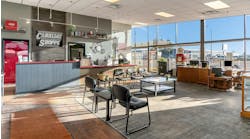Mike Anderson grew up in the collision industry. Though he spent his years after high school serving time in the Air Force and attending college, he eventually came back to his father’s dealership and began his successful career in the industry by writing estimates. He eventually became the owner of Wagonwork Collision Centers in Alexandria, Va., and went on to start his own business.
Today, he operates CollisionAdvice.com, a training and consulting firm that provides shop operators across the country with the resources for improving their business. Anderson is also a facilitator for Axalta Coating Systems’ 20 groups in the U.S. and Canada and an Accredited Automotive Manager. As one of the most popular business coaches in the industry, Anderson knows the game of collision repair like the back of his hand.
HOW DOES THE INDUSTRY TODAY COMPARE TO WHAT IT WAS LIKE 20 YEARS AGO?
I think the biggest difference today is that vehicles are much more complex. There are both positives and negatives to this, but there are so many more variables we’re working with in the collision industry today.
In November 1985, I entered the industry as an adult, and back then vehicles were still pretty basic. A handful of vehicles had power windows and mirrors, but most were manual. Vehicles 20 years ago may have had three different types of hardware holding a bumper on, whereas today there might be six. Repairs were much simpler. With all of the computerized technology that’s onboard a vehicle today, there’s a lot more liability at stake.
That being said, I also think we have a lot more available to us today. Back then there was I-CAR training and Audi was one of the first manufacturers to come out with a training program. There weren’t nearly as many resources and training options to choose from.
Even with social media coming into play, it’s much easier to reach out and network with people. There’s a lot more discussion between people in the industry, talking about trends and how we can do repairs safely and properly.
WHAT HAS BEEN THE BIGGEST GAME CHANGER OVER THE PAST 20 YEARS?
In the past five to seven years, I think the biggest game changer has been the involvement of the OEMs in our industry. Over the past 20 years, there have been many improvements. Shop systems and technologies have become a lot more efficient and user friendly. Now, there’s a lot more OEM interaction, and I think that’s a good thing for our trade.
Before, you would go to an industry event and see all of the typical attendees: insurers, shop owners and vendors. Twenty years ago we didn’t see very many OEMs participate in industry events, and I think this shift is probably one of the biggest game changers I’ve seen.
WHAT DO SHOPS NEED TO DO TO BE SUCCESSFUL OVER THE NEXT 20 YEARS?
I think it’s absolutely vital that shops understand that every aspect of the business is involving a lot of computers, including repair. Vehicles are becoming more and more connected with technologies like OnStar, Toyota Safety Connect or Hyundai Blue Link.
The connected car is going to change how everything works, and I think it’s going to especially change how we approach fixing vehicles. It’s going to be very interesting and very exciting to see how this takes shape in our industry in the next 20 years. In order to be successful, shops need to be prepared and get excited for more technology in their work.



